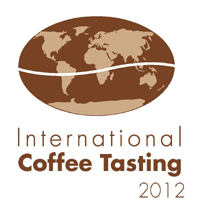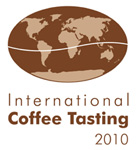International Coffee Tasting 2012: The Winners
For two days judges from various countries tasted and assessed coffee from all over the world
 Brescia, 7 november – The fourth edition of the International Coffee Tasting held in Brescia on the 29th and 31st October has closed. Coffees from all around the world have been challenging each other. 26 judges from 11 countries were given the task of assessing as many as 113 coffees from 13 countries: the winning products of the competition were chosen from a truly international selection (Editor’s note: the list is below).
Brescia, 7 november – The fourth edition of the International Coffee Tasting held in Brescia on the 29th and 31st October has closed. Coffees from all around the world have been challenging each other. 26 judges from 11 countries were given the task of assessing as many as 113 coffees from 13 countries: the winning products of the competition were chosen from a truly international selection (Editor’s note: the list is below).
"The winning coffees possess an exceptionally wide range of aromas – commented Luigi Odello, president of the International Institute of Coffee Tasters and Professor of Sensory Analysis at various Italian and foreign universities – accompanied by a bold but round and smooth body".
Among the competing products there were also coffee pods and capsules, a phenomenon which has increasingly grown in recent years. It is very interesting to observe how these coffees come very close to perform as espresso, but are still not able to reach its silkiness, rich body and powerful aroma.
"It is equally interesting to see how non Italian espresso roasters are progressing – concluded Odello – Many of them are definitely trying to align themselves with the Italian style ".
The competition sponsors were Wega Macchine per Caffè, Luigi Bormioli and Compak. The competition also enjoyed the patronage of the Italian Ministry of Agriculture, Food and Forestry Policies and of the International Academy of Sensory Analysis.
The winners of International Coffee Tasting 2012 (ex aequo, in alphabetic order with the name of the winning product in brackets)
Espresso – Italian blends
- Costadoro, Turin (Coffee Lab)
- Esperia Distribuzione, Monza Brianza (Caffè Milano)
- G.I.Fi.Ze, Bologna (Club Kavè)
- Holly di Ulivieri Raffaele, Perugia (Bar 100% Arabica)
- Italcaffè, La Spezia (Excelso Bar)
- La Genovese, Savona (Caffè Anniversario Metal Box)
- La Genovese, Savona (Caffè Qualità Royal)
- Milani, Como (Milani Gran Espresso)
- Mokaor, Vercelli (Intenso)
- Omkafè, Trento (Superbar blend)
- Taurocaf di Alberto & Anzola, Turin (Caffè Alberto Pappagallo Rosso Blend)
- Torrefazione Caffè Gran Salvador, Brescia (100% Arabica CE)
- Torrefazione Caffè Gran Salvador, Brescia (100% Arabica N)
- Torrefazione Caffè Roen, Verona (Espresso Bendinelli – 100% Arabica Gourmet)
- Torrefazione dei F.lli Morandini, Brescia (Maxima Blend 100% Arabica)
- Torrefazione El Miguel, Varese (La Cafferia – Portofino)
- Torrefazione Olimpica, Rieti (Faraglia Espresso Barrique)
- Torrefazione S. Salvador, Sondrio (Super Bar)
Espresso – Non Italian blends or single origins
- Cafés Dromedario, Spain (Dromedario Colombia Nariño Supremo "El Tambo")
- Cafés Dromedario, Spain (Pozo Artesania)
- Cafés Dromedario, Spain (Tostadora Natural Hosteleria)
- Caffè Principe, Germany (Ottanta)
- Droga Kolinska, Slovenia (Barcaffè Bar)
- Gourmet Coffee Roasters, South Africa (Häzz)
- Milano Coffee, Canada (Espresso # 1)
- P & F Coffee, Thailand (P & F Espresso Blend)
- P & F Coffee, Thailand (P & F Splendid Blend)
- Peaberry, Thailand (House Blend Coffee Roasted)
- Peaberry, Thailand (Roadster Blend Coffee Roasted)
Coffee pods and capsules
- Caffè Agust, Brescia (Natura Equa Biofairtrade capsule)
- Mocoffee, Switzerland (Bel Canto – Strato Coffee Machine)
- Torrefazione Caffè Roen, Verona (Monodose Capsule)
Coffee for non-professional automatic coffee machines
- Milani, Como (Milani Guatemala Antigua El Pulcal)
 The third edition of International Coffee Tasting, the international coffee contest organized by the International Institute of Coffee Tasters, ended on October 27. For two days, 27 tasters from nine different countries (Italy, Japan, Poland, Slovakia, Slovenia, Sweden, Switzerland, Serbia, Germany) evaluated 121 coffees from Italy, Germany, Mexico, Poland, Slovenia, Spain, Switzerland, Thailand, and the USA.
The third edition of International Coffee Tasting, the international coffee contest organized by the International Institute of Coffee Tasters, ended on October 27. For two days, 27 tasters from nine different countries (Italy, Japan, Poland, Slovakia, Slovenia, Sweden, Switzerland, Serbia, Germany) evaluated 121 coffees from Italy, Germany, Mexico, Poland, Slovenia, Spain, Switzerland, Thailand, and the USA.

